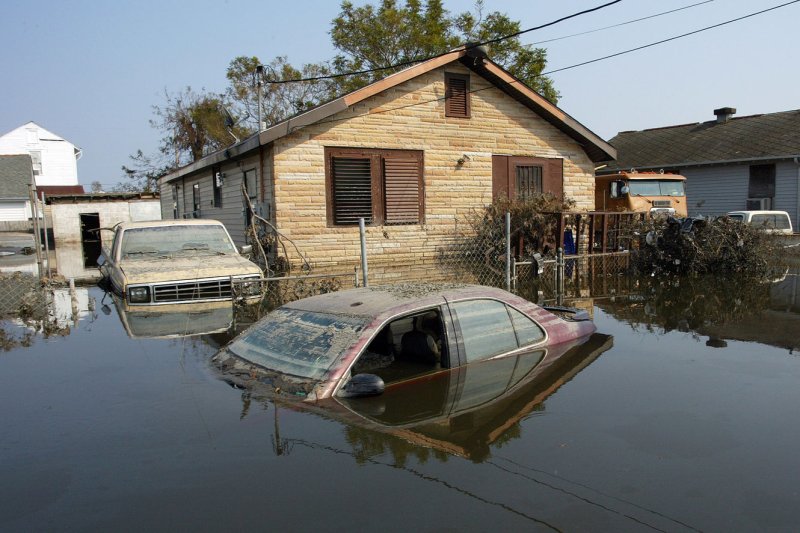Flood water from a levee break, caused by Hurricane Katrina, fills the streets of the Ninth Ward of New Orleans on September 3, 2005. Hurricane Harvey could overtake Katrina as the most costly natural disaster in U.S. history. File Photo by A.J. Sisco/UPI |
License Photo
Aug. 30 (UPI) -- As floodwaters still rise in some parts of Southeast Texas, weather experts are predicting Hurricane Harvey could become the most costly natural disaster in U.S. history.
AccuWeather President Joel N. Myers on Wednesday called Harvey a 1,000-year flood, and warned that some parts of Houston will be "uninhabitable for weeks and possibly months due to water damage, mold, disease-ridden water."
"This will be the worst natural disaster in American history," he said. "The economy's impact, by the time its total destruction is completed, will approach $160 billion, which is similar to the combined effect of Hurricanes Katrina and Sandy. The disaster is just beginning in certain areas."
While the figures for Harvey's economic impact aren't yet finalized, it's hard not to compare the storm damage to other costly natural disasters in U.S. history.
The Top 5 most expensive natural disasters by estimated CPI-adjusted cost are:
Hurricane Katrina ($160 billion)
File Photo by Vincent Laforet/Pool/UPI
Hurricane Katrina affected a number of U.S. states and areas in the Caribbean, but had perhaps the biggest economic impact in the greater New Orleans area, where levees broke and caused massive flooding.
The National Oceanic and Atmospheric Administration's list of weather and climate disasters indicates the Category 3 hurricane cost $160 billion when accounting for inflation.
The high cost was due to severe storm surge damage, wind damage and the failure of New Orleans' levee system, and inland, high winds and some flooding. The storm and subsequent flooding killed 1,833 people.
Northridge earthquake ($33.5 billion-$73.67 billion)
The 6.7-magnitude Northridge earthquake struck California's San Fernando Valley on Jan. 17, 1994. It killed 60 people and injured more than 7,000.
Cost estimates -- by experts including the U.S. Geological Survey and researchers -- of the temblor vary between $33.5 billion and $73.67 billion
The quake produced the highest ground acceleration felt in U.S. history and could be felt in Las Vegas some 220 miles away.
Hurricane Sandy ($70.2 billion)
File Photo by John Angelillo/UPI
Hurricane Sandy -- also known as Superstorm Sandy -- was the largest Atlantic hurricane on record, stretching some 1,100 miles across while off the coast of the U.S. Northeast. NOAA estimates it cost an inflation-adjusted $70.2 billion.
Sandy sent a storm surge through the streets of New York and New Jersey, and killed 233 people in eight countries.
Hurricane Andrew ($47 billion)
An aerial view of Dade County, Florida, showing damage from one of the most destructive hurricanes in the history of the United States. Hurricane Andrew did extensive damage to homes in Miami, leaving little behind in its wake. One million people were evacuated and 54 died in this hurricane. File Photo courtesy FEMA
Hurricane Andrew made landfall on Florida's southeastern shore Aug. 24, 1992, as a Category 5 storm. It destroyed tens of thousands of homes, killed 65 people and cost an inflation-adjusted $47 billion.
Much of the damage from the storm was caused by wind speeds that topped 165 mph and tornadoes spawned by the system.
1988 Drought/heatwave ($42.4 billion)
The worst drought in U.S. history affected the Midwest and even closed some schools in South Dakota. There were record-setting heat waves and long spells without any precipitation.
The drought was responsible for about 5,000 deaths due to heat stress and at its peak covered about 45 percent of the country. Economic loss came from hits to the agricultural industry.




















